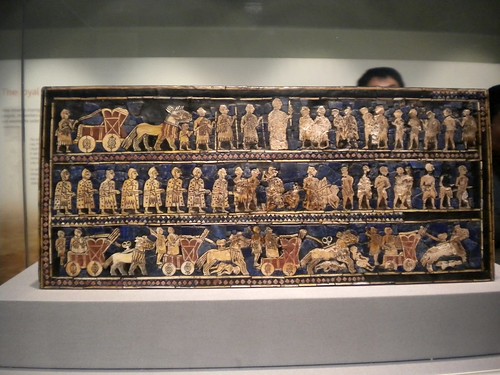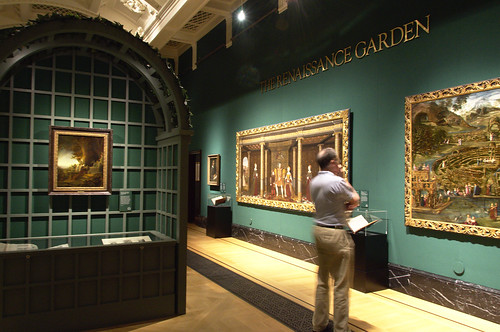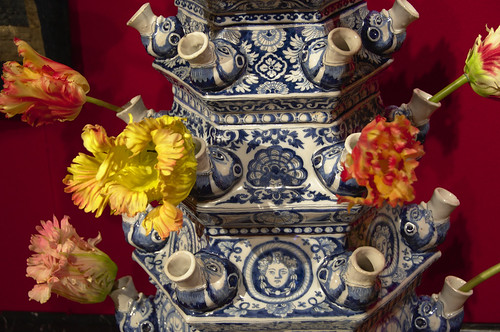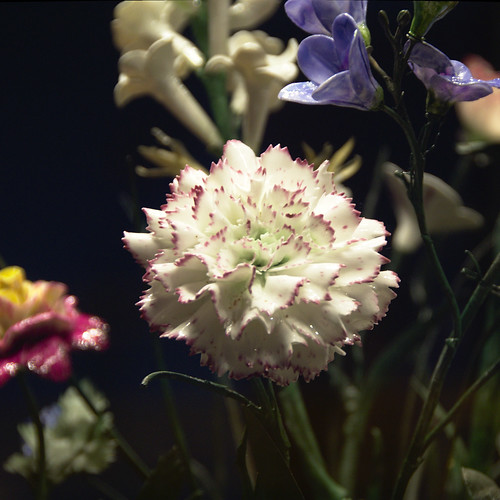This is the second half of the second chapter of this book (I’ve read a lot more of it I promise you, it’s just the blog posts are lagging behind both in terms of being written and in terms of being published; you never know, I may’ve finished the book before you read this!).
The Fertile Crescent
Neolithic Era
We now move into the Neolithic era – the first farmers, who definitely live in permanent settlements and grow their own food (both plant and animal). There is also a shift from relatively small groups to larger communities and a move from an egalitarian society to a stratified one. Archaeologists divide the Neolithic into four phases. The first two of these are called Pre-Pottery Neolithic A (PPNA) and Pre-Pottery Neolithic B (PPNB) – not the most catchy of names, but the important point here is that pottery develops relatively late compared to agriculture or sedentarism. PPNA runs from c.9800-8800BC, PPNB is the next couple of thousand years (8800-6800BCE). This sequence is based on excavations at Jericho, which is thought to be the oldest site where agriculture is found. During PPNA Jericho was a regional centre, covering 6 acres with satellite villages within a day or two’s walk. Anatolian obsidian and imported greenstone artifacts have been found at Jericho, as well as the first monumental structures: a stone tower approximately 8m high with an internal staircase, which was used as a burial place. Göbleki Tepe was another regional centre during this period.
During PPNB communities became much larger, the villages from this period are around 34 acres in size. The Neolithic way of life was spreading outside the Levantine area. Burial practices were becoming more elaborate. Since late Natufian times people were buried with their heads removed then placed in the grave. During PPNB some skulls would be disintered and plastered and decorated. After some time (“after long usage” says the book) the decorated skulls would be reburied in groups. Society was also becoming more stratified – a consequence of the closer proximity of larger numbers of people. Archaeologists can tell that by things like the variation in house sizes, and access to useful resources (like burnt lime in this case). The larger social groups also lead to more widespread use of art and cult objects – to bind people together with shared cultural experiences. There’s evidence of some sort of magical use of cattle figurines (perhaps to ensure success in hunting). There are also signs of ancestor cults – see above about the decorated skulls, but also large statues that are interpreted as divine ancestors. Which the book notes are reminiscent of biblical and Sumerian legends about the creation of mankind from the earth, being made of mud and plaster.
During the Pottery Neolithic periods (c. 6800BC-5800BC) the new technology of pottery changes how households are organised – it gives more options for preparing, cooking and storing food. Sites from this period have more rubbish dumps and more storage areas as people have more possessions. Over time there is an increase in complexity of Neolithic settlements – each village gets bigger, and the houses get larger. Dwellings were now built around courtyards – a style that’s still used in the Middle East today – with from 8 to 24 rooms around the courtyard, suitable for housing an extended family rather than just a nuclear family (as was the case with pre-pottery Neolithic dwellings).
Having introduced the Neolithic cultures in overview, the book now moves on to consider a couple of aspects of Neolithic life in more detail, plus a couple of the cultures of the late pre-Pottery Neolithic/early pottery Neolithic period. The first section is about the domestication of animals. This happened after the beginnings of farming, and took a few millenia before people had the suite of animals available that we expect today. It can be a bit difficult to tell when and where an animal species begins to be domesticated, but progress of domestication can be tracked to a fair degree from archaeological evidence. At first it was a case of keeping wild animals in a protective environment, but then inbreeding, and human selection, began to change the domesticated species towards smaller & less aggressive animals (which can be seen through things like horn size). I’d always assumed that a food animal would be the first domesticated species but it turns out that domestication of the dog began significantly before other animals – c.12,000BCE which is during the Natufian culture at the end of the Paleolithic period. Sheep and goats were next, c.9,000BCE, followed by pigs and cattle over the next 3000 years. The various beasts of burden were much later – donkeys c.4000BCE, horses c.1500BCE (in the Middle East, earlier elsewhere) and camels 1200BCE. Domestication of food animals also allowed the agricultural way of life to spread into the more arid areas of the region – with nomadic pastorialism becoming the main way of life in the desert regions by the end of PPNB.
The new lifestyle of the Neolithic – farming and permanent settlements – allowed populations to grow beyond the limits the hunter-gather lifestyle had imposed. This didn’t just mean that villages increased in size, it also meant that there was pressure for people to move to new areas and set up new villages there. There’s a suite of technologies that are sometimes called “the Neolithic Package” which are first seen in the Levant, and then spread from there through Asia, Europe and Africa. As outside the Levant everything seems to arrive at once in any given area it’s assumed that this whole way of life spread (with people?) from the Levant. The technologies are domesticated plants (wheat, barley, peas), domesticated animals (goats, sheep, cattle and pigs), three flint tool types (arrowheads, sickle-blades and axes), digging wells for water supplies, various cultic characteristics (Mother Goddess figurines and dancing scenes). And later pottery is part of the mix. (Note (as the book does) that domestication of plants and animals did take place independently in China.) This period (PPNB) is also when the Mediterranean islands of Cyprus and Crete were colonised – there’s evidence of flourishing villages with all the technology of the day. I find this faintly astonishing – boats feel like sophisticated technology to me, so the idea that people could sail the Mediterranean before they had knowledge of pottery is surprising.
‘Ain Ghazal is a major Neolithic site near modern Amman in Jordan. It starts as a normal small village but during the PPNB period it reaches 35 acres in size – one of the largest settlements of the time. Each house was made up of one or two rectangular rooms, with floors and walls plastered with lime plaster. There are also round storage spaces. Burials of the community show evidence of stratification – some individuals have richer burials than others in “better” sites. The skulls may be removed and decorated – sometimes the decoration is removed and buried again (without the skull, which may’ve been redecorated). The more elaborate burials were under the floors of the houses, less elaborate ones were in pits outside houses. And still others appear to’ve been placed in rubbish dumps. The most important discoveries from ‘Ain Ghazal are the art objects – lots of animal figurines, mostly cattle. And some of the earliest statues of humans – made from reed frames which are coated with plaster and hae painted features. The book notes in passing that some of these have 6 fingers or toes, which seems odd to me. After the PPNB period ‘Ain Ghazal declines – it shrinks, and the number of art objects discovered also drop off.
Çatal Hüyük (in modern Anatolia) is the next Neolithic site discussed in the book, but the two page spread feels rather like it’s been rather brutally edited down from a larger piece and the remaining text isn’t quite coherent. There are no dates for the site in the text, although they refer to it as the “earliest city”. It had around 5,000 inhabitants, in houses that are packed so closely together there’s no ground between them – access is from the roof via ladders. There are lots of burials within the houses, under the sleeping platforms. These are described as family groups in the book, but a TV series we watched recently (Ascent of Woman) interviewed an archaeologist currently working on the site who says that recent DNA evidence shows the groups are no more related with in the group than across the whole population. Which he interpreted as children being fostered out to other familes – interesting if so as that’s not really a social pattern we see any more (I think!). Some famous figurines have been found at this site too – including statuettes of a woman (the Mother Goddess?) giving birth on a chair/throne flanked by two leopards or lions. The really exciting thing about the Çatal Hüyük site is that there aren’t just figurines but also wall paintings. Although there appears to have been some doubt about the reality of these? There’s an off-hand reference in the text to newer excavations finding evidence that “Mellaart’s initial claims […] to be more reliably based than first suspected.”. Which is … an interesting turn of phrase, particularly after they mention that Mellaart got chucked out of Turkey when he fell out with the authorities there over this excavation. But I do rather wish this section had told us more about the city and dropped fewer hints about scandals of archaeology! A tangent to follow up on one day! 🙂
The last few sections of this chapter start narrowing the focus down to Mesopotamia – as the following chapter is about early urbanisation in that region. The Late Neolithic (pottery Neolithic) looks in retrospect like a filler period between two stages in cultural development – it’s after the “Neolithic Revolution” of agriculture and before the “Urban Revolution”. I’m not sure I like this way of thinking about it but the book does go on to explain that we don’t know much about the period – mostly it’s characterised by different types of pottery without much other feel for the cultures. Interestingly administration and a concept of property exist during this period – I’d assumed that came in with cities – but there’s evidence from 6,000BCE from Tell Sabi Abyad in Syria of clay sealings for jars or rooms which show if someone who shouldn’t have has opened it. The period is divided into four broad cultures – pre-Hassuna, Hassuna , Samarra and Halaf. The latter three are named after the sites the cultures were first discovered. The Samarran culture is the one that Tell Sabi Abyad belongs to – the book positions it as a sort of proto-Sumerian culture. Not only are there the clay sealings there are also clay tokens that may be the very early antecedents of cuneiform writing. And some symbolism may prefigure later Mesopotamian religious iconography – particularly scorpion motifs (later associated with the goddess Ishtar).
With the arrival of pottery archaeology gets quite a bit easier. Pottery doesn’t decay, even if broken, and large amounts of it are made (and thrown out). Functional vessels can be made in a large variety of styles, and different cultures tend to have different fashions & traditions. This gives you information about trade networks and about how cultures evolved over time. Different styles within a culture can also demonstrate things about social stratification. In the Halufian culture of Late Neolithic Mesopotamia in particular very fine pottery was used as elite status symbols. Pottery at the time would’ve been the (relatively) new technology and also the exotic metals or other materials (such as ivory) used for later status objects weren’t as available.
The Halaf culture was primarily in the north of Mesopotamia, and overlapping slightly with them were the southern Mesopotamia based Ubaid culture. This is the last of the pre-urban (and pre-historic) cultures that the book considers. Ubaid culture begins in the south and then spreads throughout the rest of Mesopotamia and beyond – whether by migration of people or trading of objects & ideas is unclear. As well as the physical artifacts this culture is characterised by the development of the first irrigation canal networks. This is an important stepping stone on the way to urbanisation in Mesopotamia. The canals make agriculture a bit easier, thus freeing up labour for other purposes like crafting or bureaucracy. They also require a more complex degree of social organisation – someone(s) needs to make decisions about what is built, someone(s) needs to organise the labour force and so on.
The next chapter of the book moves on to the rise of true urban settlements – as well as the development of writing and the beginning of city states.






